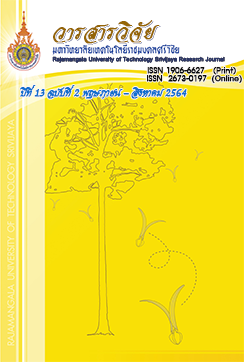Efficiency of Palm Oil Mill Fly Ash for Residential Building Wastewater Treatment
Keywords:
Fly ash, Wastewater, Adsorption, IsothermAbstract
This research investigated the efficiency of palm oil mill fly ash for residential building wastewater treatment. The objective was to study the effects of pH value, contact time and optimum dosage of palm oil mill fly ash, including removal efficiency. The experiments were carried out in the batch test. Results showed that the optimum pH value was 6 with COD removal efficiency of 60.00±8.94%. The optimum contact time was 60 minutes with COD removal efficiency of 62.96±9.07%. The influence of palm oil mill fly ash dosage on adsorption efficiency was 2 g of palm oil mill fly ash per 100 mL of wastewater, allowing the highest COD removal efficiency of 84.62±9.73%. The turbidity was varied according to palm oil mill fly ash dosage. The study of adsorption isotherm revealed that COD adsorption with palm oil mill fly ash corresponded to Langmuir isotherm.
References
Al-Zboon, K., Al-Harahsheh, M.S. and Hani, F.B. 2011. Fly ash-based geopolymer for Pb removal from aqueous solution. Journal of Hazardous Materials 188(1-3): 414-421.
Bansode, R.R., Losso, J.N., Marshall, W.E., Rao, R.M. and Portier, R.J. 2004. Pecan shell-based granular activated carbon for treatment of chemical oxygen demand (COD) in municipal wastewater. Bioresource Technology 94: 129-135.
Chansuvarn, W. 2016. Research Report no Modification of adsorbent surface for removal of lead(II) ion from aqueous solution. Faculty of Science and Technology, Rajamangala University of Technology Phra Nakhon. (in Thai)
Chingono, K.E., Sanganyado, E., Bere, E. and Yalala B. 2018. Adsorption of sugarcane vinasse effluent on bagasse fly ash: A parametric and kinetic study. Journal of Environmental Management 224: 182-190.
Department of Environmental Quality Promotion. 2005. Guidebook for Community Wastewater Management. 4thed. Thammasat Printing house, Bangkok. (in Thai)
Department of Industrial Works. 2011. Water Pollution Treatment Systems Textbook. 7thed. Department of Industrial Works, Ministry of industry, Bangkok. (in Thai)
Hawari, A., Rawajfih, Z. and Nsour, N. 2009. Equilibrium and thermodynamic analysis of zinc ions adsorption by olive oil mill solid residues. Journal of Hazardous Materials 168: 1284-1289.
Jaturapitakkul, C. 2012. Biomass ash from industrial: Problems, limitations and utilization. Concrete Journal 17: 1-10. (in Thai)
Kulkarni, S.J., Patil, S.V. and Bhalerao, Y.P. 2011. Fly ash adsorption studies for organic matter removal accompanying increase in dissolved oxygen. International Journal of Chemical Engineering and Applications 2(6): 434-438.
Lakdawala, M.M. and Lakdawala, J.M. 2012. Adsorption study of BOD content from sugar industry wastewater by low cost material fly ash. Der Chemica Sinica 3(2): 497-502.
Mohan, S. and Gandhimathi, R. 2009. Removal of heavy metal ions from municipal solid waste leachate using coal fly ash as an adsorbent. Journal of Hazardous Materials 169: 351-359.
Mor, S., Chhoden, K. and Ravindra, K. 2016. Application of agro-waste rice husk ash for the removal of phosphate from the wastewater. Journal of Cleaner Production 129: 673-680.
Nayl, A.E.A., Elkhashab, R.A., Malah, T.E., Yakout, S.M., El-Khateeb, M.A., Ali, M.M.S. and Ali, H.M. 2017. Adsorption studies on the removal of COD and BOD from treated sewage using activated carbon prepared from date palm waste. Environmental Science and Pollution Research 24: 22284-22293.
Office of Agricultural Economics. 2020. Palm Oil. Available Source: http://mis-app.oae.go.th/product/ปาล์มน้ำมัน, May 5, 2020. (in Thai)
Painmanakul, P. 2014. Unit Processes for Environmental Engineering. 1sted. Chulalongkorn University Press, Bangkok. (in Thai)
Pandey, P.K., Sharma, S.K. and Sambi, S.S. 2010. Kinetics and equilibrium study of chromium adsorption on zeoliteNaX. International Journal of Environmental Science and Technology 7(2): 395-404.
Piyang, T., Sagulsawasdipan, K. and Sawain, A. 2018. A study of palm oil fuel ash in manufacturing in production footpaths concrete stabs. Wichcha Journal 37(1): 81-94. (in Thai)
Police, S., Maity, S., Chaudhary, D.K., Dusane, C.K., Sahu, S.K. and Kumar, A.V. 2020. Effect of coal fly ash's particle size on U adsorption in water samples and thermodynamic study on adsorption. Environmental Chemistry and Ecotoxicology 2: 32-38.
Pollution control department. 2018a. Water Pollution. Available Source: http://www.pcd.go.th/info_serv/reg_polwater.html, September 25, 2018. (in Thai)
Pollution control department. 2018b. Domestic Wastewater. Available Source: http://www.pcd.go.th/info_serv/water_wt.html, September 29, 2018. (in Thai)
Sun, D., Zhang, X., Wu, Y. and Liu, X. 2010. Adsorption of anionic dyes from aqueous solution on fly ash. Journal of Hazardous Materials 181: 335-342.
Srikun, S. 2007. The Study of adsorption of dye and lead ion with activated carbon prepared from durian peels. Master Thesis of Engineering in Chemical Engineering, King Mongkut’s Institute of Technology North Bangkok. (in Thai)
Sirianuntapiboon, S. 2006. Wastewater Treatment System. Top, Bangkok. (in Thai)
Syafiqah, M.S.I. and Yussof, H.W. 2018. Adsorption of mercury from aqueous solutions using palm oil fuel ash as an adsorbent - batch studies. IOP Conference Series: Materials Science and Engineering 334: 1-5.
Tungkananuruk, N. and Tungkananuruk, K. 2012. Principle of Chemical Water Quality Analysis. 2nded. Kasetsart University Press, Bangkok. (in Thai)
Tunsathien, P. 2013. A study of properties of palm oil fuel from various sources for use in concrete. Master Thesis of Engineering in Civil Engineering, King Mongkut's University of Technology Thonburi. (in Thai)
Udomsinrot, K. 2007. Wastewater Engineering. 4thed. Siam Stationery Supply, Bangkok. (in Thai)
Visa, M., Andronic, L. and Duta, A. 2015. Fly ash-TiO2 nanocomposite material for multi-pollutants wastewater treatment. Journal of Environmental Management 150: 336-343.
Visa, M., Isac, L. and Duta, A. 2012. Fly ash adsorbents for multi-cation wastewater treatment. Applied Surface Science 258: 6345-6352.
Waijarean, N. and Asavapisit, S. 2019. Synthesis of geopolymer from water treatment residue and palm oil fuel ash. The Journal of Industrial Technology 15(2): 70-86. (in Thai)
Downloads
Published
How to Cite
Issue
Section
License
The content and information in the article published in Journal of Rajamangala University of Technology Srivijaya It is the opinion and responsibility of the author of the article. The editorial journals do not need to agree. Or share any responsibility.







